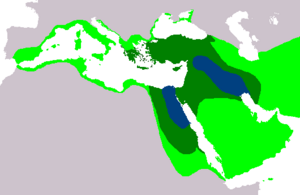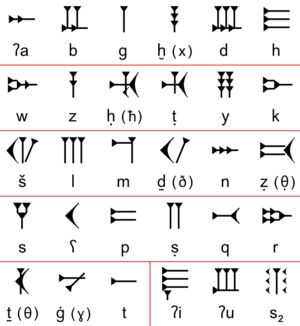Ugaritic alphabet facts for kids
Quick facts for kids Ugaritic |
|
|---|---|

The Ugaritic writing system
|
|
| Type | Abjad |
| Spoken languages | Ugaritic, Hurrian, Akkadian |
| Time period | from around 1400 BCE |
| Parent systems |
Egyptian hieroglyphs?
|
| Unicode range | U+10380–U+1039F |
| ISO 15924 | Ugar |
| Note: This page may contain IPA phonetic symbols in Unicode. | |
The Ugaritic writing system was an ancient way of writing. It used marks pressed into clay, like other cuneiform scripts. But unlike most cuneiform, it was an abjad, which is a type of alphabet where mostly consonants are written. It also had some parts that showed vowels. People used this system around 1400 BCE or 1300 BCE for the Ugaritic language. This was an old language from the Middle East that is no longer spoken.
The Ugaritic writing system was found in 1928 in a place called Ugarit. This area is now known as Ras Al Shamra in Syria. This writing system has 30 letters. Sometimes, other languages like Hurrian were also written using the Ugaritic script in the Ugarit area.
Clay tablets written in Ugaritic are very important. They show us the earliest examples of how alphabets were ordered in both the North Semitic and South Semitic ways. These orders led to many other famous alphabets. For example, the Phoenician alphabet and its family, like Hebrew and Latin, came from the North Semitic order. The Geʽez script came from the South Semitic order. The Arabic script is another Semitic alphabet that has many letters for sounds, similar to Ugaritic.
The Ugaritic script was written from left to right. Even though it used cuneiform shapes pressed into clay, its symbols were not related to the Akkadian cuneiform system.
Contents
How the Ugaritic Writing System Worked
The Ugaritic writing system was a special kind of abjad. In most words, only the consonant sounds were written down. This included sounds like /w/ and /j/ found in diphthongs (two vowel sounds together). What made Ugaritic unusual was that it also showed vowels that came after a glottal stop (a sound made by briefly closing your throat, like the "uh-oh" sound).
It's believed that the letter for the sound /ʔa/ (a glottal stop followed by 'a') first stood for just the glottal stop sound. Later, it was only used for /ʔa/. Then, two more letters were added to the end of the alphabet for /ʔi/ (glottal stop with 'i') and /ʔu/ (glottal stop with 'u').
There was a final letter in the alphabet, called s2, whose purpose is still debated. It looks similar to the 's' in later Semitic scripts. However, it was only used in certain words, often words borrowed from other languages. Some experts think it represented a foreign sound that was similar to the native /s/ sound. Others suggest it might have been a syllabic sound like /su/.
The last three letters of the alphabet were likely first created to write down words from other languages, like Akkadian and Hurrian language. Later, they were also used for the Ugaritic language itself. When writing other languages, these three letters (which showed glottal stop plus a vowel) were used as simple vowel letters.
The only punctuation mark used in Ugaritic writing was a word divider. This mark helped separate words on the clay tablets.
Where Did Ugaritic Script Come From?
When the Ugaritic script was used (around 1300–1190 BCE), Ugarit was an important place. It was located right in the middle of a world where writing was developing. This included powerful areas like Egypt, Anatolia, Cyprus, Crete, and Mesopotamia.
Ugaritic combined the idea of a Semitic abjad (an alphabet mostly for consonants) with the cuneiform way of writing. Cuneiform involved pressing a stylus (a pointed tool) into soft clay. Scholars have looked for connections between Ugaritic letters and Mesopotamian cuneiform, but they haven't found any direct links.
Some researchers now think that Ugaritic might be a form of the Proto-Sinaitic script. They believe the letter shapes might have changed to fit the method of writing on clay with a stylus. There might also have been some influence from the Byblos syllabary, which is a writing system we don't fully understand yet.
It has been suggested that the two main shapes in Ugaritic cuneiform – a straight wedge (like 𐎂) and a corner wedge (like 𐎓) – might match lines and circles in older Semitic alphabets. For example, the three Semitic letters that had circles, and are still seen in the Greek alphabet (like Θ, O) and Latin (like Q), are all made with corner wedges in Ugaritic: 𐎉 (ṭ), 𐎓 (ʕ), and 𐎖 (q). Other letters also look similar to their Greek relatives. Some experts, like Jared Diamond, believe the alphabet was carefully designed. He points out that letters with fewer strokes might have been used more often.
Ugaritic Alphabet Orders
Lists of Ugaritic letters, called abecedaries, have been found in two different orders. These lists are like our "ABC" songs.
The "Northern Semitic order" is similar to the order found in the Phoenician, Hebrew, and Arabic alphabets. It's also distantly related to the order of the Greek and Latin alphabets.
The "Southern Semitic order" is more like the order found in the South Arabian and Geʽez scripts.
Here are the letters in their two main orders:
North Semitic Order
| Letter: | 𐎀 | 𐎁 | 𐎂 | 𐎃 | 𐎄 | 𐎅 | 𐎆 | 𐎇 | 𐎈 | 𐎉 | 𐎊 | 𐎋 | 𐎌 | 𐎍 | 𐎎 | 𐎏 | 𐎐 | 𐎑 | 𐎒 | 𐎓 | 𐎔 | 𐎕 | 𐎖 | 𐎗 | 𐎘 | 𐎙 | 𐎚 | 𐎛 | 𐎜 | 𐎝 |
| Transliteration: | ʾa | b | g | ḫ | d | h | w | z | ḥ | ṭ | y | k | š | l | m | ḏ | n | ẓ | s | ʿ | p | ṣ | q | r | ṯ | ġ | t | ʾi | ʾu | s2 |
South Semitic Order
| Letter: | 𐎅 | 𐎍 | 𐎈 | 𐎎 | 𐎖 | 𐎆 | 𐎌 | 𐎗 | 𐎚 | 𐎒 | 𐎋 | 𐎐 | 𐎃 | 𐎁 | 𐎔 | 𐎀 | 𐎓 | 𐎑 | 𐎂 | 𐎄 | 𐎙 | 𐎉 | 𐎇 | 𐎏 | 𐎊 | 𐎘 | 𐎕 | [ | 𐎛 | 𐎜 | 𐎝 | ] | ||
| Transliteration: | h | l | ḥ | m | q | w | š | r | t | s | k | n | ḫ | b | ś | p | ʾa | ʿ | ẓ | g | d | ġ | ṭ | z | ḏ | y | ṯ | ṣ | [ | ʾi | ʾu | s2 | ] |
The Ugaritic Letters
Here is a table showing the Ugaritic letters, their common transliteration (how they are written using our alphabet), their sound in the IPA, and how they compare to letters in the Phoenician and Hebrew alphabets.
| Sign | Trans. | IPA | Phoenician | Hebrew |
|---|---|---|---|---|
| 𐎀 | ʾa | ʔa | 𐤀 | אַ |
| 𐎁 | b | b | 𐤁 | ב |
| 𐎂 | g | ɡ | 𐤂 | ג |
| 𐎃 | ḫ | x | — | — |
| 𐎄 | d | d | 𐤃 | ד |
| 𐎅 | h | h | 𐤄 | ה |
| 𐎆 | w | w | 𐤅 | ו |
| 𐎇 | z | z | 𐤆 | ז |
| 𐎈 | ḥ | ħ | 𐤇 | ח |
| 𐎉 | ṭ | tˤ | 𐤈 | ט |
| 𐎊 | y | j | 𐤉 | י |
| 𐎋 | k | k | 𐤊 | כ |
| 𐎌 | š | ʃ | 𐤔 | ש |
| 𐎍 | l | l | 𐤋 | ל |
| 𐎎 | m | m | 𐤌 | מ |
| 𐎏 | ḏ | ð | — | — |
| 𐎐 | n | n | 𐤍 | נ |
| 𐎑 | ẓ | θˤ | — | — |
| 𐎒 | s | s | 𐤎 | ס |
| 𐎓 | ʿ | ʕ | 𐤏 | ע |
| 𐎔 | p | p | 𐤐 | פ |
| 𐎕 | ṣ | sˤ | 𐤑 | צ |
| 𐎖 | q | q | 𐤒 | ק |
| 𐎗 | r | r | 𐤓 | ר |
| 𐎘 | ṯ | θ | — | — |
| 𐎙 | ġ | ɣ | — | — |
| 𐎚 | t | t | 𐤕 | ת |
| 𐎛 | ʾi | ʔi | — | — |
| 𐎜 | ʾu | ʔu | — | — |
| 𐎝 | s2 | su | — | — |
| 𐎟 | word divider | 𐤟 | — | |
Shorter Ugaritic Alphabets
There were also two shorter versions of the Ugaritic alphabet. These were found in places outside of Ugarit, like Tel Beit Shemesh, Sarepta, and Tiryns. Unlike the main Ugaritic alphabet found on clay tablets, these shorter versions were usually written on other objects. They were also typically written from right to left, instead of left to right. One version had 27 letters, and the other had 22 letters. We don't know for sure which of these Ugaritic alphabets came first.
Ugaritic Script in Computers
The Ugaritic script was added to the Unicode Standard in April 2003. This happened when version 4.0 of Unicode was released. Unicode helps computers show text from many different writing systems correctly.
The special section for Ugaritic in Unicode is U+10380–U+1039F.
| Ugaritic[1][2] Official Unicode Consortium code chart: https://www.unicode.org/charts/PDF/U10380.pdf (PDF) |
||||||||||||||||
| 0 | 1 | 2 | 3 | 4 | 5 | 6 | 7 | 8 | 9 | A | B | C | D | E | F | |
| U+1038x | 𐎀 | 𐎁 | 𐎂 | 𐎃 | 𐎄 | 𐎅 | 𐎆 | 𐎇 | 𐎈 | 𐎉 | 𐎊 | 𐎋 | 𐎌 | 𐎍 | 𐎎 | 𐎏 |
| U+1039x | 𐎐 | 𐎑 | 𐎒 | 𐎓 | 𐎔 | 𐎕 | 𐎖 | 𐎗 | 𐎘 | 𐎙 | 𐎚 | 𐎛 | 𐎜 | 𐎝 | 𐎟 | |
| Notes | ||||||||||||||||
In March 2019, with the release of Unicode 12.0, six more letters were added to help with transliterating (writing Ugaritic sounds using Latin letters). These new letters are:
- Error using : Input "A7BA" is not a hexadecimal value.
- Error using : Input "A7BB" is not a hexadecimal value.
- Error using : Input "A7BC" is not a hexadecimal value.
- Error using : Input "A7BD" is not a hexadecimal value.
- Error using : Input "A7BE" is not a hexadecimal value.
- Error using : Input "A7BF" is not a hexadecimal value.
See also
- Old Persian cuneiform – a much later, unrelated attempt at a cuneiform semi-alphabet.



